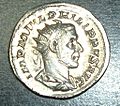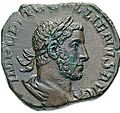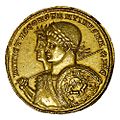Roman Dacia facts for kids
Quick facts for kids Provincia DaciaἘπαρχία Δακίας |
|||||||
|---|---|---|---|---|---|---|---|
| Province of the Roman Empire | |||||||
| 107–275 | |||||||
 Roman province of Dacia (125 AD) |
|||||||
| Capital | Ulpia Traiana Sarmizegetusa | ||||||
| Historical era | Classical Antiquity | ||||||
|
• Annexed by Trajan
|
107 | ||||||
|
• Withdrawal by Roman Emperor Aurelian
|
275 | ||||||
|
|||||||
| Today part of | |||||||
The Roman province of Dacia was a land in ancient times. It was located in the Balkans region. Today, this area includes parts of Romania (like Transylvania, Banat, and Oltenia) and sometimes southern Moldova.
Dacia became a part of the mighty Roman Empire after a big war. This happened under the Roman Emperor Trajan. What's interesting is that Dacia was a very rich province. But it was also the first Roman province that Rome ever gave up. This happened much later, when the Romans decided to leave.
Contents
The Dacians Before Rome
Before the Romans arrived, Dacia was a strong kingdom. It was home to a people called the Dacians. Their kingdom was quite large around the year 100 AD.
The Dacians were known for their bravery. They had a powerful king named Decebalus. He was a skilled leader and warrior. The Dacians also had valuable resources, especially gold. This gold was one of the main reasons the Romans became interested in their land.
Trajan's Conquest of Dacia
The Roman Empire was always looking to expand. They also wanted to control valuable resources. Dacia's gold mines and fertile lands were very appealing. This led to a series of major conflicts. These wars are known as the Trajan's Dacian Wars.
Emperor Trajan led the Roman armies. He was a very famous and successful Roman emperor. The wars against the Dacians were tough. But the Romans, with their strong army, eventually won. King Decebalus was defeated.
After the wars, in 107 AD, Dacia officially became a Roman province. This was a huge victory for the Roman Empire. To celebrate this, Trajan built a famous monument in Rome. It is called Trajan's Column. This column tells the story of the wars in pictures carved into the stone.
Life in Roman Dacia
Once Dacia became a Roman province, many changes happened. The Romans brought their way of life to the region.
- New Cities: The Romans built new cities and towns. One important city was Ulpia Traiana Sarmizegetusa. It became the capital of the Roman province of Dacia. You can still see the ruins of its amphitheatre today.
- Roman People: Many Roman citizens moved to Dacia. They were soldiers, traders, and farmers. They helped to develop the province.
- Resources: The Romans took control of Dacia's gold mines. This wealth helped to fund the Roman Empire. They also used the land for farming.
- Culture: The Dacians started to adopt Roman customs. They learned Latin, the Roman language. This process is called Romanization. It means people in conquered lands started to become more like Romans.
Later Roman Emperors and Dacia
After Trajan, other Roman emperors ruled Dacia. They worked to keep the province safe and prosperous.
- Emperor Hadrian: He ruled after Trajan. Hadrian visited Dacia and even had coins minted to remember his visit. He made sure the borders were strong.
- Emperor Antoninus Pius: He continued to rule Dacia peacefully.
- Emperor Marcus Aurelius: During his time, the Roman Empire faced many challenges. But Dacia remained an important province.
- Emperor Septimius Severus and Caracalla: These emperors also maintained Roman control over Dacia. They were part of the Severan dynasty.
For many years, Dacia was a valuable part of the Roman Empire. It provided resources and helped protect the Roman borders.
The Roman Withdrawal from Dacia
By the 3rd century AD, the Roman Empire faced many problems. There were attacks from outside groups. Also, the empire was very large and hard to defend.
Around 275 AD, Emperor Aurelian made a big decision. He decided to withdraw the Roman army and many Roman citizens from Dacia. This was because it was becoming too difficult and costly to defend the province. It was the first time Rome completely gave up a province.
The Romans moved their people and administration south of the Danube River. Even though the Romans left, their influence remained. The language spoken in modern Romania, Romanian, is a Romance language. This means it developed from Latin, the language of the Romans. This shows how strong the Romanization of Dacia was.
Images for kids
-
The Dacian Kingdom around 100 AD, before the Roman conquest
-
Trajan's Column in 1820
-
A captive Dacian, Capitoline Museums, Piazza del Campidoglio, Rome
-
The lower Danube in Roman times map by Gustav Droysen
-
The sanctuaries in the ruined Sarmizegetusa Regia, the capital of ancient Dacia
-
Emperor Hadrian (117–138), as depicted in the Antalya Museum
-
Bronze coin of the emperor Hadrian commemorating his visit to Dacia
-
Emperor Antoninus Pius (138–161)
-
Statue of Emperor Marcus Aurelius (161–180), on Piazza del Campidoglio, Rome
-
Emperor Pertinax (193). Statue found at Apulum. On display at the National Museum of the Union, Alba Iulia, Romania.
-
Emperor Septimius Severus (193–211). Marble bust from the Glyptothek in Munich.
-
Bust of Emperor Caracalla (211–217). Cast in the Pushkin Museum (Moscow) after original in Naples.
-
A sestertius minted to commemorate the province of Dacia and its legions
-
The amphitheatre at Ulpia Traiana Sarmizegetusa
-
Emperor Philip the Arab (244–249)
-
Emperor Aurelian (270–275)
-
Emperor Diocletian (284–305)
-
Emperor Constantine I (306–337)
See also
 In Spanish: Dacia (provincia romana) para niños
In Spanish: Dacia (provincia romana) para niños























